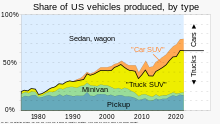In the United States, the automotive industry began in the 1890s and, as a result of the size of the domestic market and the use of mass production, rapidly evolved into the largest in the world. The United States was the first country in the world to have a mass market for vehicle production and sales and is a pioneer of the automotive industry[1] and mass market production process.[2][3] During the 20th century, global competitors emerged, especially in the second half of the century primarily across European and Asian markets, such as Germany, France, Italy, Japan and South Korea. The U.S. is currently second among the largest manufacturers in the world by volume.
American manufacturers produce approximately 10 million units annually.[4] Notable exceptions were 5.7 million automobiles manufactured in 2009 (due to crisis), and more recently 8.8 million units in 2020 due to the global COVID-19 pandemic.[4][5]Production peaked during the 1970s and early 2000s at 13–15 million units.[6][7][8]
Starting with Duryea in 1895, at least 1,900 different companies have been formed, producing over 3,000 makes of American automobiles.[9] World War I (1917–1918) and the Great Depression in the United States (1929–1939) combined to drastically reduce the number of both major and minor producers. During World War II, all the auto companies switched to making military equipment and weapons. By the end of the 1950s the remaining smaller producers disappeared or merged into amalgamated corporations. The industry was dominated by three large companies: General Motors, Ford, and Chrysler, all based in Metro Detroit. Those "Big Three" continued to prosper, and the U.S. produced three-quarters of all automobiles in the world by 1950, 8.0 million out of 10.6 million produced. In 1908, 1 percent of U.S. households owned at least one automobile, while 50 percent did in 1948 and 75 percent did in 1960.[10][11] Imports from abroad were a minor factor before the 1960s.[7][8]
Beginning in the 1970s, a combination of high oil prices and increased competition from foreign auto manufacturers severely affected the US companies. In the ensuing years, the US companies periodically bounced back, but by 2008 the industry was in turmoil due to the aforementioned crisis. As a result, General Motors and Chrysler filed for bankruptcy reorganization and were bailed out with loans and investments from the federal government. June 2014 seasonally adjusted annualized sales were the biggest in history, with 16.98 million vehicles and toppled the previous record of July 2006.[12] Chrysler later merged into Fiat as Fiat Chrysler and is today a part of the multinational Stellantis group. American electric automaker Tesla emerged onto the scene in 2009 and has since grown to be one of the world's most valuable companies, producing around 1/4th of the world's fully-electric passenger cars.
Prior to the 1980s, most manufacturing facilities were owned by the Big Three (GM, Ford, Chrysler) and AMC. Their U.S. market share has dropped steadily as numerous foreign-owned car companies have built factories in the U.S. As of 2012, Toyota had 31,000 U.S. employees, compared to Ford's 80,000 and Chrysler's 71,100.[13]


The development of self-powered vehicles was accompanied by numerous technologies and components giving rise to numerous supplier firms and associated industries. Various types of energy sources were employed by early automobiles including steam, electric, and gasoline. Thousands of entrepreneurs were involved in developing, assembling, and marketing of early automobiles on a small and local scale. Increasing sales facilitated production on a larger scale in factories with broader market distribution. Ransom E. Olds and Thomas B. Jeffery began mass production of their automobiles. Henry Ford focused on producing an automobile that many middle class Americans could afford.
A patent filed by George B. Selden on 8 May 1879 covered not only his engine but its use in a four-wheeled car. Selden filed a series of amendments to his application which stretched out the legal process, resulting in a delay of 16 years before the patent was granted on 5 November 1895.[16] Selden licensed his patent to most major American automakers, collecting a fee on each car they produced and creating the Association of Licensed Automobile Manufacturers. The Ford Motor Company fought this patent in court, and eventually won on appeal. Henry Ford testified that the patent did more to hinder than encourage development of autos in the United States.[17]
Originally purchased by wealthy individuals, by 1916 cars[which?] began selling at $875. Soon, the market widened with the mechanical betterment of the cars, the reduction in prices, as well as the introduction of installment sales and payment plans. During the period from 1917 to 1926, the annual rate of increase in sales was considerably less than from 1903 to 1916. In the years 1918, 1919, 1921, and 1924 there were absolute declines in automotive production. The automotive industry caused a massive shift in the industrial revolution because it accelerated growth by a rate never before seen in the U.S. economy. The combined efforts of innovation and industrialization allowed the automotive industry to take off during this period and it proved to be the backbone of United States manufacturing during the 20th century.[18]

The practicality of the automobile was initially limited because of the lack of suitable roads. Travel between cities was mostly done by railroad, waterways, or carriages. Roads were mostly dirt and hard to travel, particularly in bad weather. The League of American Wheelmen maintained and improv